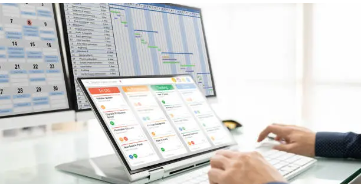In the mid 80’s, Hirotaka Takeuchi and Ikujiro Nonaka defined a flexible and all-inclusive product development strategy where the development team works as a unit to reach a common goal.
They described an innovative approach to product development that they called a holistic or “rugby” approach, “where a team tries to go the distance as a unit, passing the ball back and forth.” They based their approach on manufacturing case studies from various industries.
Takeuchi and Nonaka proposed that product development should not be like a sequential relay race, but rather should be analogous to the game of rugby where the team works together, passing the ball back and forth as they move as a unit down the field.
The rugby concept of a “Scrum” (where a group of players form together to restart the game) was introduced in this article to describe the authors’ proposal that product development should involve “moving the Scrum downfield”.
Ken Schwaber and Jeff Sutherland elaborated on the Scrum concept and its applicability to software development in a presentation at the Object-Oriented Programming, Systems, Languages & Applications (OOPSLA) conference held in 1995 in Austin, Texas.
Since then, several Scrum practitioners, experts, and authors have continued to refine the Scrum conceptualisation and methodology. In recent years, Scrum has increased in popularity and is now the preferred project development methodology for many organisations globally.
Why Use Scrum?
Some of the key benefits of using Scrum in any project are:
- Adaptability—Empirical process control and iterative delivery make projects adaptable and open to incorporating change.
- Transparency—All information radiators like a Scrumboard and Sprint Burndown Chart are shared, leading to an open work environment.
- Continuous Feedback—Continuous feedback is provided through the Conduct Daily Standup, and Demonstrate and Validate Sprint processes.
- Continuous Improvement—The deliverables are improved progressively, Sprint by Sprint, through the Groom Prioritised Product Backlog process.
- Continuous Delivery of Value—Iterative processes enable the continuous delivery of value through the Ship Deliverables process as frequently as the customer requires.
- Sustainable Pace—Scrum processes are designed such that the people involved can work at a sustainable pace that they can, in theory, continue indefinitely.
- Early Delivery of High Value—The Create Prioritized Product Backlog process ensures that the highest value requirements of the customer are satisfied first.
- Efficient Development Process—Time-boxing and minimising non-essential work lead to higher efficiency levels.
- Motivation—The Conduct Daily Standup and Retrospect Sprint processes lead to greater levels of motivation among employees.
- Faster Problem Resolution—Collaboration and colocation of cross-functional teams lead to faster problem solving.
- Effective Deliverables—The Create Prioritized Product Backlog process and regular reviews after creating deliverables ensures effective deliverables to the customer.
- Customer Centric—Emphasis on business value and having a collaborative approach to stakeholders ensures a customer-oriented framework.
- High Trust Environment—Conduct Daily Standup and Retrospect Sprint processes promote transparency and collaboration, leading to a high trust work environment ensuring low friction among employees.
- Collective Ownership—The Approve, Estimate, and Commit User Stories process allows team members to take ownership of the project and their work, leading to better quality.
-
- High Velocity—A collaborative framework enables highly skilled cross-functional teams to achieve their full potential and high velocity.
- Innovative Environment—The Retrospect Sprint and Retrospect Project processes create an environment of introspection, learning, and adaptability, leading to an innovative and creative work environment.
Action Point
PS: I know you might agree with some of the points raised in this article or disagree with some of the issues raised.
Please share your thoughts on the topic discussed. We would appreciate it if you could drop your comment. Thanks in anticipation.
WhatsApp: @CRMNuggets Community
Follow Us on Facebook: CRMNuggets
Follow on X Platform
Follow on TikTok @crmnuggets


